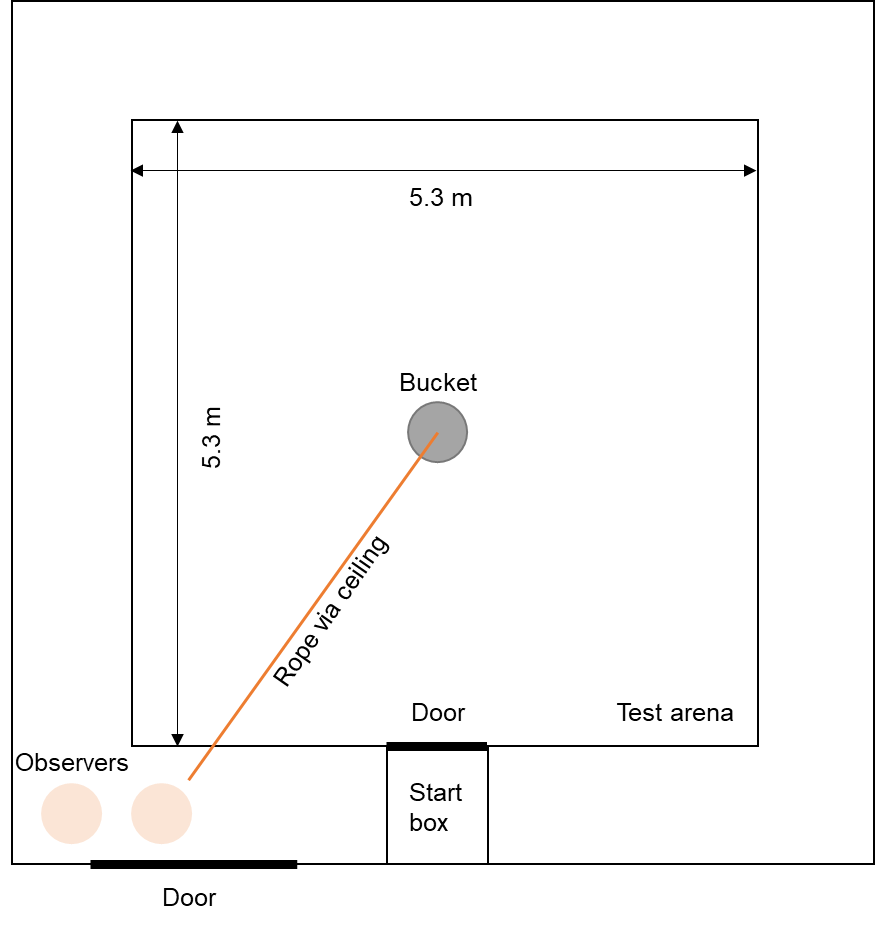Advanced Search
Novel environment test and novel object test
Last updated date: Jul 18, 2022 Views: 535 Forks: 0
Protocol Novel Environment Test and Novel Object Test
Background:
Being confronted with an unfamiliar situation, object, or event is known to elicit a fear response in animals (Gray, 1987), therefore the responses of an animal towards a novel environment or a novel object can indicate the degree of the fearfulness of this animal (Forkman et al., 2007). For pigs, an increased vocalization and defecation frequency, an increased time spent standing in alert position, a decreased time spent on exploratory behaviours, and a higher latency to explore a novel object have been linked to increased fearfulness (Brown et al., 2009; Dalmau et al., 2009; Forkman et al., 2007; Reimert et al., 2013; Ursinus et al., 2013). Therefore these behaviours are recorded in response to a novel environment and subsequent novel object in order to assess and compare pig fearfulness.
Materials:
- Test arena (Figure 1)
- Transport cart
- 2 Tablets with Noldus Observer 3.3 (Noldus Information Technology B.V., Wageningen, The Netherlands) containing the ethograms for observing behaviour and vocalizations
- 2 pens
- Remark sheet
- Paper towels
- Cleaning solution
- Water
- Squeegee
Figure 1. Test arena of 5.3 × 5.3 m with 1 m high hardwood walls.

People:
- 1 for observing behaviour
- 1 for observing vocalizations
- 1 for transporting pigs
General:
Behavioural events, vocalizations, excretions as well as locomotive and exploration behaviours are continuously scored for 10 minutes using 2 tablets with Noldus Observer, one for states (“observer behaviours”) and one for single events (“observer vocalizations”). The first 5 minutes after entering the novel environment arena, the activity and vocalizations of the animal are continuously observed. After the novel object (a metal bucket) is introduced into the centre of the test arena, not only the general activity and vocalizations are observed for 5 minutes, but also the attention toward this object are registered. During the observation both observers quietly sit on a chair at the side of the arena. They avoid staring at the pig.
Method:
- Open the correct programs in Noldus Observer on the tablets and fill in the independent variables.
- Transfer the piglet to the test arena by gently lifting the piglet out of the pen and putting it in a cart, carefully closing the lid of the cart, and bringing the cart to the arena.
- For “Observer vocalizations”: place the piglet in the start box of the test arena. Gently guide the piglet towards the test arena, and when the piglet has entered the arena, close the door behind it.
- When the door is closed, “observer behaviours” says “start” and then both observers start the observation on the tablet.
- After 4 minutes and 55 seconds, “Observer vocalizations” starts the Novel Object Test by quickly lowering a metal bucket from the ceiling until it touches the floor at the centre of the arena and remains on the floor. “Drop novel object” is entered on the tablet by both observers at the moment the metal bucket touches the floor. Five minutes after dropping the bucket the test ends.
- After the test the piglet is transported back to the home pen. The test arena is cleaned by removing faeces and using water and cleaning solution, and the floor is dried with a squeegee.
- Save observations on tablets.
- Clean the cart in between pigs when necessary.
Ethogram:
| Item | Description |
| Exclusive behavioural states | |
| Exploring environment | Sniffing, nosing, rooting, chewing, or licking the floor or wall |
| Exploring object | Sniffing, nosing, rooting, chewing, or licking the object |
| Drawing back | Quickly moving a few steps away from the object after being oriented towards the object |
| Other | Performing any other behaviour |
| Exclusive postural and locomotive states | |
| Moving | Walking or running |
| Freezing | Standing motionless on four legs with head fixed (up or down) and ears upright |
| Standing | Standing motionless on four legs, not alert |
| Sitting | Sitting or kneeling on the floor |
| Lying | Lying with side or belly touching the floor |
| Behavioural events | |
| Defecating | Excreting faeces |
| Urinating | Excreting urine |
| High-pitched vocalizations | Screams, squeals, or grunt-squeals |
| Low-pitched vocalizations | Short or long grunts |
Independent variables for the observation program:
- Date
- Day (11/12)
- Time
- Pen
- Ear tag
- Colour (Orange or Purple)
- Observer initials
- Remarks (if necessary)
File name:
| Observer initials (e.g. AI) |
| Observation type (B for behaviour, V for vocalizations) |
| Pen: 1-16 |
| Pig: O (orange) or P (purple) |
| Day: 1 (Thursday) or 2 (Friday) |
| Example: Allyson is observing the behaviour of pig orange from pen 4 on Friday. The file name will be AIB4O2. |
- Ipema, A(2022). Novel environment test and novel object test. Bio-protocol Preprint. bio-protocol.org/prep1803.
- Ipema, A. F., Bokkers, E. A. M., Gerrits, W. J. J., Kemp, B. and Bolhuis, J. E.(2021). Providing live black soldier fly larvae (Hermetia illucens) improves welfare while maintaining performance of piglets post-weaning. Scientific Reports 0(0). DOI: 10.1038/s41598-021-86765-3
Do you have any questions about this protocol?
Post your question to gather feedback from the community. We will also invite the authors of this article to respond.
Tips for asking effective questions
+ Description
Write a detailed description. Include all information that will help others answer your question including experimental processes, conditions, and relevant images.
Share
Bluesky
X
Copy link
